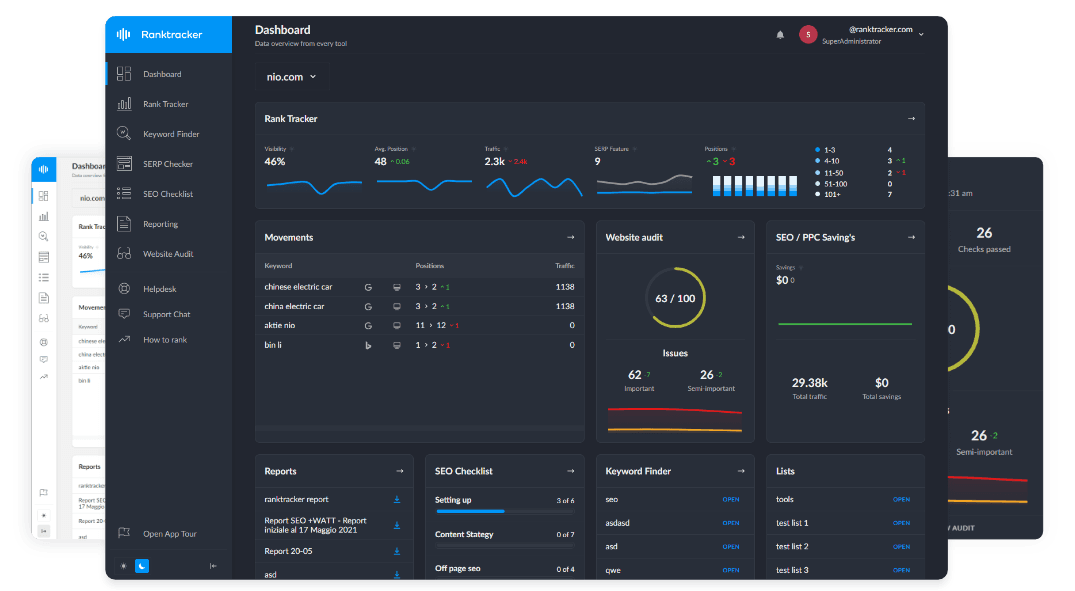Intro
Animal-assisted therapy is a powerful and growing field that combines professional therapeutic practices with the presence of trained animals to support mental, emotional, and physical healing. Whether you offer equine-assisted therapy, dog-assisted counseling, or in-facility animal programs, having a strong online presence is essential. SEO (Search Engine Optimization) helps ensure your services are visible to the people actively seeking this unique form of care.
With the help of Ranktracker’s SEO tools, you can increase local visibility, reach more clients, and establish trust within a competitive landscape.
Why SEO Matters for Animal-Assisted Therapy
People searching for animal-assisted therapy are often dealing with personal challenges or seeking non-traditional support for their children, loved ones, or themselves. Your ability to show up in search results during this time can make a meaningful difference in someone’s life.
Effective SEO can help you:
-
Increase visibility for therapy-related searches in your area
-
Build trust and credibility through content and reviews
-
Educate your audience about the value of animal-assisted care
-
Encourage referrals from professionals and institutions
Keyword Research for Therapy and Support Needs
Understanding how people search for these services is crucial. Your keywords should cover both specific services and emotional needs.
Examples of effective keywords include:
-
“animal-assisted therapy near me”
-
“dog therapy for anxiety”
-
“equine therapy for veterans”
-
“therapy animals for autism”
-
“animal-assisted mental health programs [city]”
Ranktracker’s Keyword Finder helps you identify relevant, low-competition, and location-specific keywords to build your strategy around what people are actually searching for.
On-Page SEO for Therapy Practices
Every page on your site should clearly communicate your offerings and speak directly to the concerns of your target audience.
Best practices include:
-
Create individual service pages for equine therapy, canine-assisted sessions, group therapy, and school programs
-
Use structured headings (H1, H2, H3) to make content readable and SEO-friendly
-
Add title tags and meta descriptions that include your target keywords and location
-
Include clear calls to action like “Schedule a Consultation” or “Learn More About Our Animal Partners”
-
Add an FAQ section to address common questions and improve voice search visibility
Local SEO to Connect with Nearby Clients
Animal-assisted therapy is typically location-based, and your SEO should reflect that.
To improve your local visibility:
-
Claim and fully optimize your Google Business Profile with services, images, and contact info
-
Use local keywords throughout your website (e.g., “equine therapy in [city name]”)
-
List your business in local therapy directories and educational institution databases
-
Encourage client reviews and respond with empathy and professionalism
-
Add your service areas clearly on your homepage and contact page
Content That Educates and Builds Trust
People unfamiliar with animal-assisted therapy may need guidance. Quality content can educate them and showcase your expertise.
The All-in-One Platform for Effective SEO
Behind every successful business is a strong SEO campaign. But with countless optimization tools and techniques out there to choose from, it can be hard to know where to start. Well, fear no more, cause I've got just the thing to help. Presenting the Ranktracker all-in-one platform for effective SEO
We have finally opened registration to Ranktracker absolutely free!
Create a free accountOr Sign in using your credentials
Content ideas:
-
Blog posts: “How Animal-Assisted Therapy Helps Children with Anxiety,” “Benefits of Equine Therapy for Trauma Recovery”
-
Informative videos introducing your therapy animals and explaining how sessions work
-
Testimonials and success stories (with permission) that build emotional connection
-
Downloadable guides like “How to Choose the Right Animal-Assisted Program”
Ranktracker tools can help you monitor content performance and refine your strategy based on what readers engage with most.
Visual SEO for Emotionally-Driven Services
Visuals play a significant role in communicating warmth, professionalism, and comfort.
Make the most of your visuals by:
-
Using real images of therapy animals, clients (with permission), and your environment
-
Adding descriptive alt text to each image (e.g., “teen working with therapy horse outdoors”)
-
Naming image files clearly (e.g., “canine-therapy-session.jpg”)
-
Optimizing image size for fast loading across devices
Build Authority Through Backlinking
Trusted backlinks from reputable sites help your rankings and signal that your services are credible.
Ways to earn backlinks include:
-
Collaborating with local schools, mental health centers, and hospitals
-
Getting listed in therapy, wellness, or pet-assisted care directories
-
Writing guest content for mental health blogs, parenting websites, or nonprofit newsletters
-
Participating in interviews or community spotlights on local news platforms
Use Ranktracker’s Backlink Checker to identify existing backlinks and discover new opportunities.
Track Your Progress and Refine
As your therapy practice grows, your SEO strategy should evolve. Track performance and make data-driven improvements using Ranktracker’s full suite of tools.
Focus on:
-
Monitoring keyword rankings with the Rank Tracker
-
Running regular audits to keep your site healthy and accessible
-
Analyzing which content converts the most visitors into inquiries
-
Expanding your strategy into related terms or new service areas as needed
Final Thoughts
SEO for animal-assisted therapy is about more than increasing web traffic—it’s about helping the right people find the support they need. With compassionate messaging, location-focused strategies, and smart tools like Ranktracker, you can make your practice discoverable, trusted, and helpful from the very first search.

